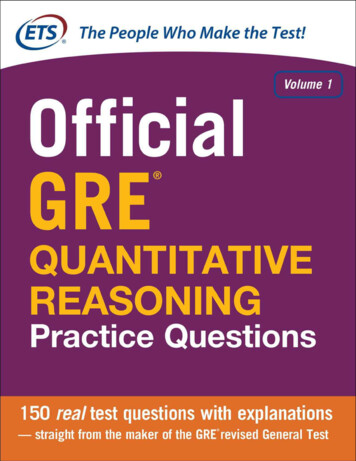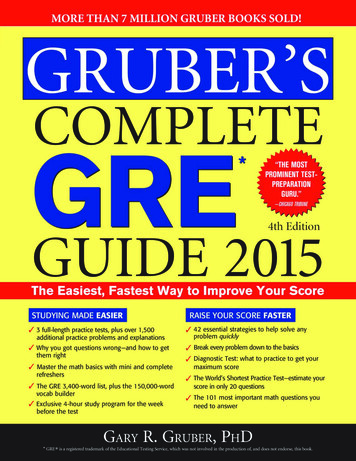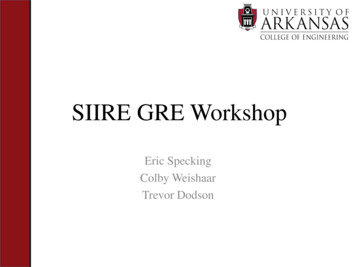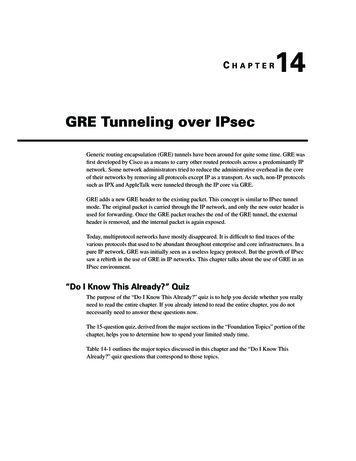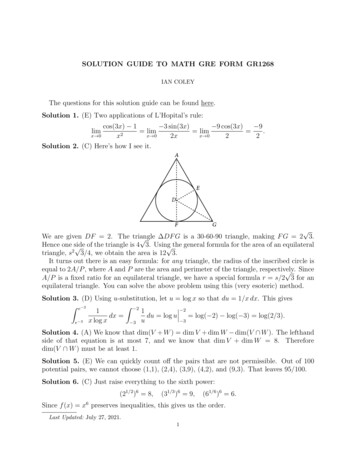
Transcription
SOLUTION GUIDE TO MATH GRE FORM GR1268IAN COLEYThe questions for this solution guide can be found here.Solution 1. (E) Two applications of L’Hopital’s rule: 9 cos(3x) 9cos(3x) 1 3 sin(3x) lim . lim2x 0x 0x2x22Solution 2. (C) Here’s how I see it.limx 0 We are given DF 2. The triangle DFGisa30-60-90triangle,makingFG 23. Hence one areaofanequilateral triangle, s2 3/4, we obtain the area is 12 3.It turns out there is an easy formula: for any triangle, the radius of the inscribed circle isequal to 2A/P , where A and P are the area and perimeter of the triangle, respectively. SinceA/P is a fixed ratio for an equilateral triangle, we have a special formula r s/2 3 for anequilateral triangle. You can solve the above problem using this (very esoteric) method.Solution 3. (D) Using u-substitution, let u log x so that du 1/x dx. This givesZ e 2Z 2 211dx du log u log( 2) log( 3) log(2/3). 3 3 ue 3 x log xSolution 4. (A) We know that dim(V W ) dim V dim W dim(V W ). The lefthandside of that equation is at most 7, and we know that dim V dim W 8. Thereforedim(V W ) must be at least 1.Solution 5. (E) We can quickly count off the pairs that are not permissible. Out of 100potential pairs, we cannot choose (1,1), (2,4), (3,9), (4,2), and (9,3). That leaves 95/100.Solution 6. (C) Just raise everything to the sixth power:(21/2 )6 8,(31/3 )6 9,(61/6 )6 6.Since f (x) x6 preserves inequalities, this gives us the order.Last Updated: July 27, 2021.1
2IAN COLEYSolution 7. (C) We have to do some graphical integration to determine the solution. Certainly f (2) f (0) since we have added positive area on [0, 2]. And f (4) f (2) since wehave added negative area on [2, 4]. A quick inspection shows that the semicircle of radiusone (f (2) f (4)) is far smaller than the quarter-ellipse area (f (2) f (0)). Therefore theproper ordering is f (0) f (4) f (2).Solution 8. (B) Remember that a group necessarily has inverses. Going down the list,Z \ {0} definitely does not have all multiplicative inverses. We can stop at this point.Solution 9. (A) The information given tells us that we are concave up at x 1 andconcave down on (0, 2). We also have a maximum, minimum, or saddle point at x 0.Going through our options, (A) is suitable and we can stop there. The other graphs can bechecked for their particular issues.Solution 10. (A) Squaring both sides, we can fiddle around a bit to determine what we’reactually dealing with.(x 3)2 (y 2)2 (x 3)2 y 2 (x 3)2 (x 3)2 y 2 (y 2)2 12x 4y 4.That gives us a line.Solution 11. (B) Since we are rotating around the y-axis, we should phrase things in termsof functions f (y).It’s easy to see that our integral will run from y 0 to y 1. The righthand function is x y and the lefthand function is x y. The integral we must perform isZ 1Z 1 1 22π( y) y dy πy y 2 dy π y 2 /2 y 3 /3 π(1/6 0) π/6.000Alternatively, we can use the method of cylindrical shells. Our integral will run from x 0to x 1, so the volume is given byZ 1Z 1122πx(x x ) dx 2πx2 x3 dx 2π(x3 /3 x4 /4) 2π · (1/12 0) π/6000giving us the same answer.Solution 12. (B) Any group of prime order is necessarily cyclic, and hence there is only oneup to isomorphism. This limits are choices to (B), (C), and (E). But there are two groupsof order 9 (at least): Z/3 Z/3 and Z/9. This makes (B) our only option.
SOLUTION GUIDE TO MATH GRE FORM GR12683Solution 13. (D) The maximum value of f (0) will be obtained when f ′ (x) 1 constantly.That would make f (0) 5 3 8.Solution 14. (B) Evaluating that integral at x c gives 0. Therefore we would also have3c5 96 0. A quick calculation shows c 2.Solution 15. (A) For a composition of functions, if the first function isn’t one-to-one, there’sno way the composite is. It’s worth mentioning here that the opposite is true for onto: thesecond function had better be onto.Solution 16. (B) Put another way, C A XOR B. If C is false, than either both A and Bare true or both A and B are false. (D) and (E) both work, but they’re not necessary. (B)is the only one that must be true.Solution 17. (B) We should see if (D) or (E) has more than 3 solutions to begin with. (E)only has one solution, at x 0, as the righthand side gets arbitrarily close to zero as x getslarge but sec x is bounded away from the x-axis. (D) doesn’t have any real solutions at all.(C) also only has one solution.That leaves (A) and (B). (B) is equivalent to x2 4x 15 0, and we can calculate thediscriminant is b2 4ac 96 0. Therefore it has two real solutions. For (A), we need tosolve x3 x 10 0. Its discriminant (which is worth reviewing) is 4c3 27d2 . In ourcase, we can see the discriminant is 2704 0. Therefore this polynomial has only one realroot.Note: this took a while, and the easiest way to do it (I could see) was using the discriminantof a cubic polynomial.Solution 18. (A) We should remember some of our power series. Looking at the solutions,it would be good to recall that X1xn . 1 x n 0So f (x) is the integral of the above power series, so f ′ (x) is precisely that.Solution 19. (E) Let us represent z a bi. Then our limit becomes(a bi)2a2 b2 2abi lim.(a,b) 0 (a bi)2(a,b) 0 a2 b2 2abilimIf we let a 0 (for instance), it is easy to see that the limit is equal to 1. However, if we leta b, then our limit becomes 2a2 ilim 1.a 0 2a2 iTherefore the limit does not exist.Alternatively, using the polar form of complex numbers, we have z reiθ and z re iθ .Thusr2 e 2iθ(z)2lim 2 lim 2 2iθ lim e 4iθz 0 zr 0 r er 0But this last limit no longer depends on r, so is the value e 4iθ . But θ was a variable, so thelimit depends on the angle θ at which one approaches 0 C. Therefore it does not exist.
4IAN COLEYSolution 20. (E) This limit looks suspiciously like a derivative. Indeed, noticing thate g(0), then we could rewrite this asg(g(x)) g(g(0)).x 0x 0limThat is, the derivative of g(g(x)) at x 0. By the chain rule, this is g ′ (0) g ′ (g(0)).Computing, g ′ (x) 2e2x 1 , so g ′ (0) 2e and g ′ (e) 2e2e 1 . That makes our answer4e2e 1 1 .Solution 21. (B) We have a symmetric domainodd function (e.g. f (x) here, so3 for an32f ( x)) its integral is zero. The entire term 1 t sin t cos t is an odd function becausesin3 t is odd and the other two functions are even, so its integral amounts to nothing. Therefore the entire integral is equal toZ π/4π/4 cos t dt sin t 2/2 2/2 2. π/4 π/4Solution 22. (C) It looks like our x-coordinates are running over [ 1, 1], with y dependingon x and z depending on y. To find the volume of the solid, we just need to integrate theconstant function 1. We must therefore computeZ 1 Z 2 x2Z 1 Z 2 x2 Z y 3y 3 dy dx1 dz dy dx 1x2 110Z x2 (2 x2 )2 /2 3(2 x2 ) (x2 )2 /2 3(x2 ) dx 11Z 8 8x2 dx 1 8x 8x3 /31 1 (8 8/3) ( 8 8/3) 32/3.Solution 23. (D) Examining the choices, we see S Z/10 is a subgroup of an abeliangroup. Therefore it still have an additive identity and the operation is commutative. It isalso closed under addition and multiplication. While S does not contain the multiplicativeidentity of Z/10, it does have a multiplicative identity. 6 S is such an identity, as6x (5 1)x 5x x.Since x S are all even, 5x 0, so 6x x.Solution 24. (E) Looking at our answers, we can verify directly that ( 5, 1, 1, 0) is asolution. Any multiple of ( 5, 1, 1, 0) is also a solution, which shows that (A), (B), (C), and(D) are all true – leaving only (E). Another solution, for example, is (0, 2, 8, 5)Solution 25. (A) An inflection point of h would be a local maximum or minimum of itsderivative h′ . One seems to show up around x 1.5.Solution 26. (D) Fortunately for us, Z/11 is a field. Doing some basic math, we seethat 6x 10 and 6y 10, so 6x 6y 9. Additionally, we see that 6 · 2 1, so2 · (6x 6y) x y 7.
SOLUTION GUIDE TO MATH GRE FORM GR12685Figure 1. Photo credit Jozef Skokan.Solution 27. (D) Rewriting this in exponential form, 1 i to exponentiate. Therefore(1 i)10 32ei·π/2 32i. i·π/42e. This is much easierSolution 28. (D) Seeing no better option, we can just go down the list. (A) is clearly true,and we can determine if (B) is true if we remember the appropriate formula:(f 1 )′ (x) 1f ′ (f 1 (x)).We know f (1) 4 and f ′ (1) 3. Since f is injective, it is necessary that f 1 (4) 1.Now, for our reference, g ′ (x) 2 1 x , and g ′ (1) 1/2. To verify (C),(f g)′ (1) f ′ (1)g(1) f (1)g ′ (1) 3 · 1 4 · 1/2 5.To check (D),(g f )′ (1) g ′ (f (1))f ′ (1) g ′ (4) · 3 3̸ 1/2.4Solution 29. (C) It’s probably easiest to draw this out for yourself. The maximum degreeof any vertex is 2, 3, or 4. If there is a vertex of degree 4, then our tree looks like a star.If the maximum degree of any vertex is 2, then we have a straight line. In the middle case,we obtain a 3-pointed star to which we attach one more vertex – the choice of branch yieldsisomorphic graphs. See Figure 1.Solution 30. (A) If we have that log x c · x4 at x a (and only there), then the graphsof the functions are tangent at x a. This is because log x is concave down and cx4 isconcave up, so there would necessarily be another crossing if we had log x c · x4 anywhere.Taking derivatives, we would have that 1/a c · 4a3 . From the original equation we alsohave log a c · a4 . A little bit of algebra later, we have c 4a14 , this makes log a 1/4 soa e1/4 . Therefore c 1/4e.Solution 31. (C) The easiest thing to do is probably to calculate the characteristic polynomial. 3 λ537 λ35353 17 λ3det (3 λ) det det det28 λ2 8 λ7 λ 3128 λ (3 λ)((7 λ)(8 λ) 6) (5(8 λ) 6) (15 3(7 λ)) (λ 2)(λ 5)(λ 11)(via some more algebra).
6IAN COLEYWhat works nicely for this problem in particular, though, is examining the matrices A λI3for λ {2, 3, 5}. For λ 2, we obtain 1 5 3A 2 · I3 1 5 3 1 2 6which has two identical rows so clearly has determinant zero. For λ 5, 2 5 3A 5 · I3 1 2 3 1 2 3we have the same situation. However, for λ 3, 0 5 3A 3 · I3 1 4 3 1 2 5so we can’t conclude immediately that this matrix has determinant zero. But expansion byminors along the first column is pretty straightforward: 0 5 3det 1 4 3 0 (25 6) (15 12) 16 ̸ 01 2 5Hence λ 3 is not an eigenvalue.Solution 32. (E) We can sort this out in two steps and apply the fundamental theorem toeach.!Z 0Z x4dt2t2e dt e dtdxx30For the first,ddxZ0x3de dt dxt2Zx32et dt 3x2 ex60For the second,ddx2 x6All told, our integral is x e (4xeZx8 x6x42et dt 4x3 ex80 3).Solution 33. (C) We might notice a pattern if we start deriving.f (x) x 1 xe x e x f ′ (x) xe x e x e x f (x) e xex f ′′ (x) ( f (x) e x ) e x f (x) 2e x f ′′′ (x) f (x) 3e xSo in general, the nth derivative is going to be ( 1)n (f (x) n · e x ). We want the 19thderivative, so it’s going to be (xe x e x 19e x ) (20 x)e x .
SOLUTION GUIDE TO MATH GRE FORM GR12687Solution 34. (B) An upper triangular matrix is easily verified to be invertible so long asits diagonal entries are all nonzero. Specifically, det A is still the product of its diagonalentries, so (E) and (D) and (A) are all true. (C) can easily be verified to be true bycomputing that the bottom-right corner is 25 (the product of upper triangular matrices stillbeing upper triangular). This leaves (B). (B) can be checked directly to be false: if we letx (1, 0, 0, 0, 0), then Ax x.Solution 35. (B) We can minimise the function x2 y 2 z 2 D(x, y, z). We can rewritethis function in terms of two variables since we know that (on our plane) y 3 2x 3z,giving usD(x, z) x2 (3 2x 3z)2 z 2 .To find the minimum of the function, we should compute its partial derivatives.Dx 10x 12z 12Dz 12x 20z 18A little bit of algebra gives us a solution at x 3/7 and z 9/14. This gives enoughinformation to conclude the answer is (B).The alternative way to solve this is probably best. The normal vector to this plane is(2, 1, 3). The closest point to the origin is along this vector, so is at some point (2t, t, 3t).We can solve for the t which intersects the plane:2(2t) t 3(3t) 3 14t 3 t 3/14.Plugging this back into (2t, t, 3t) gives the same answer.Solution 36. (C) This is a good time to remind ourselves WHY the false things are false.If (A) were true, it would imply that S is a connected set. (B) is certainly not true if S isa dense set. (C) is the interior of the set S, which is always open. (E) means that S wouldhave to be closed to begin with.I’m not sure what (D) is supposed to be.Solution 37. (C) P 2 P means that P is projection onto some subspace. There is noreason to believe that this should be invertible, but it should definitely be diagonalisable(with eigenbasis some basis of that subspace). III also need not be true if the subspace isanything proper or nontrivial.Solution 38. (C) The total angle measure of a 10-gon is 180 · 8 1440 . If the polygon is tobe convex, all angles must be less than 180 . If we have 5 acute angles, then the remaining5 angles would have to make up for 1440 5 · 90 990 degrees. This is impossible to doand remain convex. If we have 4 acute angles, the remaining 6 angles need to make up for 1440 4 · 90 1080 degrees. This is our edge case, so the answer must be 3 acute angles.Solution 39. (D) This problem is nonsense, far as I can tell. The outer while loop iteratesi from 2 to n, and the inner while loop prints it out (in a weird way).Solution 40. (C) There’s no reason that should be commutative. We should be a littlecareful about the distributive laws, however. For II, let f (x) x2 , g(x) 1, and h(x) 1.Then f (g h) 0, but f g f h 2. For III, we can verify it directly:((g h) f )(x) (g h)(f (x)) g(f (x)) h(f (x)) (g f )(x) (h f )(x).
8IAN COLEYBy definition, these functions are the same since their values are literally equal. This doesnot hold for II:(f (g h)) f (g(x) h(x),(f g f h)(x) f (g(x)) f (h(x)).Solution 41. (A) The first plane is determined by the normal vector (1, 1, 1), and the seconddetermined by (1, 1, 1). Therefore the slope of ℓ is determined by a vector perpendicularto those, i.e. the cross product. i j k(1, 1, 1) (1, 1, 1) det 1 1 1 (2, 0, 2).1 1 1So that is the slope of ℓ. We need this to be the normal vector for the plane in question, soit seems that (1, 0, 1) is our best bet (out of the given options).Solution 42. (E) We are taking the discrete metric on Z . As such, every singleton setis open. Moreover, since Z is countable, every set is open. Therefore every set is closedas well (having open complement). Finally, suppose f : Z X is any map of topologicalspaces. Then every f 1 (Y ) is open for Y X (whether Y is open or not) so f is continuous.Solution 43. (A) We know thatdydydt dx.dxdtTo remind you, this follows from the chain rule and rearranging:dy dxdy ·dtdx dtUsing the same trick, we have1dy .d dxd dydxd2 y .2dxdx dxdt dtTherefore let us go step by step.dxdy 2t 2 2(t 1), 12t3 12t2 12t2 (t 1).dtdtThis makes dy/dx 6t2 . Taking the derivative of that, we get 12t, and so we finally obtain12t6td2 y .dx22t 2t 1Now, the point (8, 80) corresponds to t 2. Plugging that in, we get 12/3 4.Solution 44. (B) Putting it in simpler terms,dydydy xy x x(1 y) x dx.dxdx1 yIntegrating both sides, we obtain log(1 y) x2 /2 C ′ 1 y Ce x2 /22 /2 y 1 Ce x.Solving the initial value problem gives C 2. Furthermore, as x , the second termabove vanishes so we get 1 in the limit.1Notationcredit to tric eq/.
SOLUTION GUIDE TO MATH GRE FORM GR12689Solution 45. (C) Certainly our solutions are concentrated in [0, 1]. We know that every2π/97 units in x, we get another period of cos(97x), and each period must meet y x twice.Therefore there are19797 152π/972π6.3periods in [0, 1] and about 30 meetings. There’s only one answer in that range, so we’ll stickwith it.Solution 46. (C) A very basic related rates problem. Let h be the height of the ladderfrom the ground and ℓ the distance away from the wall. This gives the relation h2 ℓ2 81.We are also given dℓ/dt 2. At the point when the top of the ladder is 3 metres above theground, the bottom of the ladder is 81 9 6 2 away. Taking a derivative, dℓdhdh 2ℓ 0 2 · 3 · 2 · 6 2 · 2 0.2h ·dtdtdt A little bit of math later shows that dh/dt 4 2, giving our answer.Solution 47. (B) A classic kind of problem. We are clearly continuous and differentiableat 0. Anywhere else, near a rational number there is an irrational number and vice versa.Therefore there can be no continuity anywhere but at 0, and hence no differentiability either.Solution 48. (B) It would be good to recall the formula for the directional derivative. Wetake the gradient of the function then take its scalar product with the normalised vector inthe direction we want. To begin, g (6xy, 3x2 , 1).At the point (0, 0, π), we have g (0, 0, 1). That works out pretty well for us. Thenormalised version of the vector (1, 2, 3) is (1/ 14, 2/ 14, 3/ 14). Dotting this with (0, 0, 1)gives 3/ 14, and since 14 3.5 or so our answer should be closer to 0.8 than 0.2.Solution 49. (B) The greatest order is given by the product of a 2-cycle and a 3-cycle actingon disjoint elements. That gives order 6.Solution 50. (D) The sum of the ideals is still an ideal: it is clearly closed under addition(using commutativity of addition), and still under left and right multiplication due to thedistributive property. The intersection of ideals is still an ideal, which is not too hard towork out. The product of ideals, however, need not be closed under addition. Consider, forexample, R Z[X], U (2, X), and V (3, X) (the ideals generated by two elements).Then we know that 2X U · V and 3X U · V , and hence we should expect 3X 2X X U · V . However, there is no way to get X as the product of an element of U and anelement of V .Solution 51. (E) The basis (C) is not orthogonal and (D) is not normal, so we can rulethose out. Moving on to the matrix itself, it would be nice to know its rank. We can throwout the second column, since it is the negation of the first, but it is not immediately clear ifthe matrix is rank 2 or rank 3.A little bit of math shows that the remaining 3 3 matrix has determinant 0, so the rankof our column space is 2. That leaves only (A) and (E), but (A) cannot be correct. Ourcolumn space contains vectors that have nonzero third entry, so cannot lie in the span ofthat basis.
10IAN COLEYAlternatively, one might notice that C4 C3 5C1 C3 5C2 , where these denote thecolumns of the original matrix. That also gives us rank 2, and we can make the conclusionas above.Solution 52. (A) Suppose we order the classes to be taught, and know in advance wewill give the first two to the first professor, etc. There are 20! ways to order these classes.However, the arrangement is the same if we do pairwise swaps of 1-2, 3-4, etc. There are 10pairs and each has 2 orientations, so there are 210 essentially the same arrangements.Solution 53. (A) If we recall the formula for differentiation under the integral, here is thegeneral way:Z b(x)Z b(x)d ′′f (x, y) dy f (x, b(x))b (x) f (x, a(x))a (x) f (x, y) dy.dx a(x)a(x) xLooking at our situation, it is simplified greatly since a(x) 0 and b(x) x. Let h(x, y) f (y)(y x) for ease of notation. ThenZ x ′g (x) h(x, x) · 1 h(x, 0) · 0 h(x, y) dy0 xZ xZ x 0 0 f (y) dy f (x) dy0′′′′′0′Then g (x) f (x) and g (x) f (x). Therefore f needs only one derivative.Solution 54. (C) We can visualise this as a rectangle in the xy-plane. Consider [0, 3] [0, 4]there. The triangle bounded by the line y x (and the sides of the rectangle) is all points(x, y) such that x y. This triangle has an area of 4.5, and the rectangle an area of 12.Then the rest of the points (where x y) contribute an area of 7.5. Hence the probabilityis 7.5/12 5/8.Solution 55. (E) We can use some partial fractions followed up by u-substitution. First,eax ebx11 .axbxbx(1 e )(1 e )1 e1 eaxNow, considerZ0 dx.1 ebxduLet u ebx . Then du b · ebx dx, so dx. Replacing this in, we need to solveb·uZ1 du.b 1 u(1 u)This requires some more partial fractions.111 .u(u 1)u u 1Putting all that together, Z Rdx11R1log 2 lim (log u log(u 1)) lim log log .bx1 eb R b R R 12b10That makes our other quantity log 2/a. A little more math gives the answer.
SOLUTION GUIDE TO MATH GRE FORM GR1268Solution 56. (D) I is certainly true, as it is easy to verify that limx function achieves some maximum on x 1. Take C to be that maximum.If we recall the formula for the landhand side for II,nXn(n 1)(2n 1)k2 n3 .6k 111log xx 0, so theAs such, no constant C is going to do the trick for all n N.III brings to mind the power series for sin x:x3 x5sin x x ···3!5!Then sin x x is the error of the first order Taylor approximation to sin x, which is givenin terms of the next term, which indeed is related to x3 . The specific formula is, for theTaylor series of order n for f (x) centred at x a, En (x) M · x a n 1,(n 1)!where M is an upper bound for f (n 1) (x) on the interval between a and x. For us, we taken 2 and a 0, and we know that f (3) (x) cos x attains a maximum of 1. This givesC 3!1 , as expected.Solution 57. (C) I is true, since limn xn must be bounded between 0 and limn 1/n 0.Unfortunately, xn does not converge inside (0, 1). There is no reason therefore that f (xn )should be a convergent sequence – suppose that f (x) 1/x, so that f (xn ) is certainly notCauchy. However, if g is uniformly continuous, then g extends to a continuous function on[0, 1]. Now xn is a convergent sequence, so limn g(xn ) g(limn xn ) g(0) exists.Solution 58. (B) For our curve r(θ), the arc length from θ to r(0) (5, 0, 0) is given byZ θ r′ (t) dt.0To find what we are actually integrating over,p r′ (θ) ( 5 sin θ, 5 cos θ, 1) r′ (θ) 25 sin2 θ 25 cos2 θ 1 26. Then L(θ) 26 · θ precisely, so θ0 26. Computing D(θ) is easy enough:p D(θ) 25 cos2 θ 25 sin2 θ θ2 25 θ2 . Plugging in θ0 gives 51 as our answer.Solution 59. (E) Out of all these options, (C) is the trickiest one to think about. There is atheorem that if B is a nilpotent matrix (i.e. B k 0 for some k), then I B is invertible. Inthe case of (C), let B I A, so that I (I A) A is invertible. This makes (C) a validcriterion. (E) is the only one which does not work – suppose we consider A the matrix givingprojection onto the xy-plane. Then the vectors (1, 0, 0), (0, 1, 0), and (1, 1, 1) are linearlyindependent but all map to nonzero vectors.Solution 60. (D) While it looks like this is the opposite of continuity, that should read‘there exists ε 0’. What the statement says is that we not only get arbitrarily far awayfrom f (1), but we must for all x sufficiently far away from 1. So as x gets very large, sodoes f (x) .
12IAN COLEYSolution 61. (E) We can set this up as a differential equation. Let s denote the amount ofsalt in the tank, and let t denote time. We have the initial condition of s(0) 3. s′ (t) dependson two factors: the salt flowing in and the salt flowing out. The salt flows in constantly ata rate of 0.08 grams per minute, and the salt flows out at a rate of 4 · (s/100) s/25 gramsper minute. Therefores′ (t) dsdsds 0.08 s(t)/25 0.04(2 s) 0.04 dt.dtdt2 sDoing the usual calculus, log(2 s) 0.04t C ′ 2 s Ce 0.04t s(t) 2 Ce 0.04t .The initial condition tells us that C 1, so s(t) 2 e 0.04t . Plugging in t 100 givesour answer.Solution 62. (C) This question greatly depends on the fact that we are in two dimensions.The complement of S within [0, 1] [0, 1] is given by all points with both coordinates rational.This set is neither closed nor open, and so neither is its complement (and hence neither isS). It is certainly not totally disconnected, and compact would imply closed and bounded(given that we are in Euclidean space).It is, in fact, connected. We can prove this because it is path connected. Suppose wehave two points (x0 , y0 ) and (x1 , y1 ). Without loss of generality, suppose x0 is irrational. Wecan travel straight from (x0 , y0 ) to (x0 , y1 ). If y1 is irrational, then we can travel straight to(x1 , y1 ). If y1 is rational, then x1 must be irrational. If y0 was irrational to begin with thenwe can travel (x0 , y0 ) to (x1 , y0 ) to (x1 , y1 ) in a corner.However, if y0 is rational, then we should take (x0 , y0 ) to (x0 , z) for some irrational z, then(x0 , z) to (x1 , z) and finally to (x1 , y1 ). Being path connected, S is connected as well.Solution 63. (E) If the supremum is positive, it will be the product of the two greatestpositive numbers in A and B or the product of the two least negative numbers in A and B.That means we should look for sup · sup or inf · inf. However, it might be the case that thesupremum is non-positive: this happens if B contains only negative numbers and A containsonly positive numbers. In that case, the greatest value in A · B (i.e. the negative number ofsmallest magnitude) will be attained by the least (positive) element of A and the greatest(negative) element of B, giving us our third option: inf A · sup B.Solution 64. (E) The surface given is the top half of the unit sphere in R3 . Don’t do thisthe hard way – use the divergence theorem. Consider the unit ball B R3 and its surface B. Then the divergence theorem tells us thatZZZZZ⃗⃗F · dS div F⃗ dV. BBThe righthand side is much more appealing. The divergence of F is just 3, so the righthandintegral is the volume of the unit ball times 3, i.e. 4π. Because the vector field F⃗ is symmetricon the z-axis, we have thatZZZZ⃗ 2⃗ 4πF⃗ · dSF⃗ · dS Bso dividing by 2 gets us the answer.S
SOLUTION GUIDE TO MATH GRE FORM GR126813Solution 65. (E) The real and imaginary parts of an analytic function must satisfy theCauchy-Riemann equations. That is, f g f g , . x y y xRenaming things for our benefit, let our function be h(x, y) f (x, y) i · g(x, y). This tellsus that g g ex sin y, ex cos y. y xThis gives us the candidate g(x, y) ex cos y C. Luckily for us, we needn’t worry about C when taking g(3, 2) g(1, 2) as it will subtract itself out. Henceg(3, 2) g(1, 2) e3 cos 2 e cos 2 (e e3 ) cos 2.Solution 66. (B) We need to pick elements of order 16 in Z/17 . It is easy to rule out16 1, since 1 has order 2. We see that 52 25 8, so there’s no way that 8 can be agenerator. We just need to verify that the order of 5 is more than 8, so we can check 58 :54 82 64 4,That makes 5 a generator.58 ( 4)2 16 ̸ 1.
SOLUTION GUIDE TO MATH GRE FORM GR1268 3 Solution 13. (D) The maximum value of f(0) will be obtained when f′(x) 1 constantly. That would make f(0) 5 3 8. Solution 14. (B) Evaluating that integral at x cgives 0. Therefore we would also have 3c5 96 0. A quick calculation shows c 2. Solution 15.
